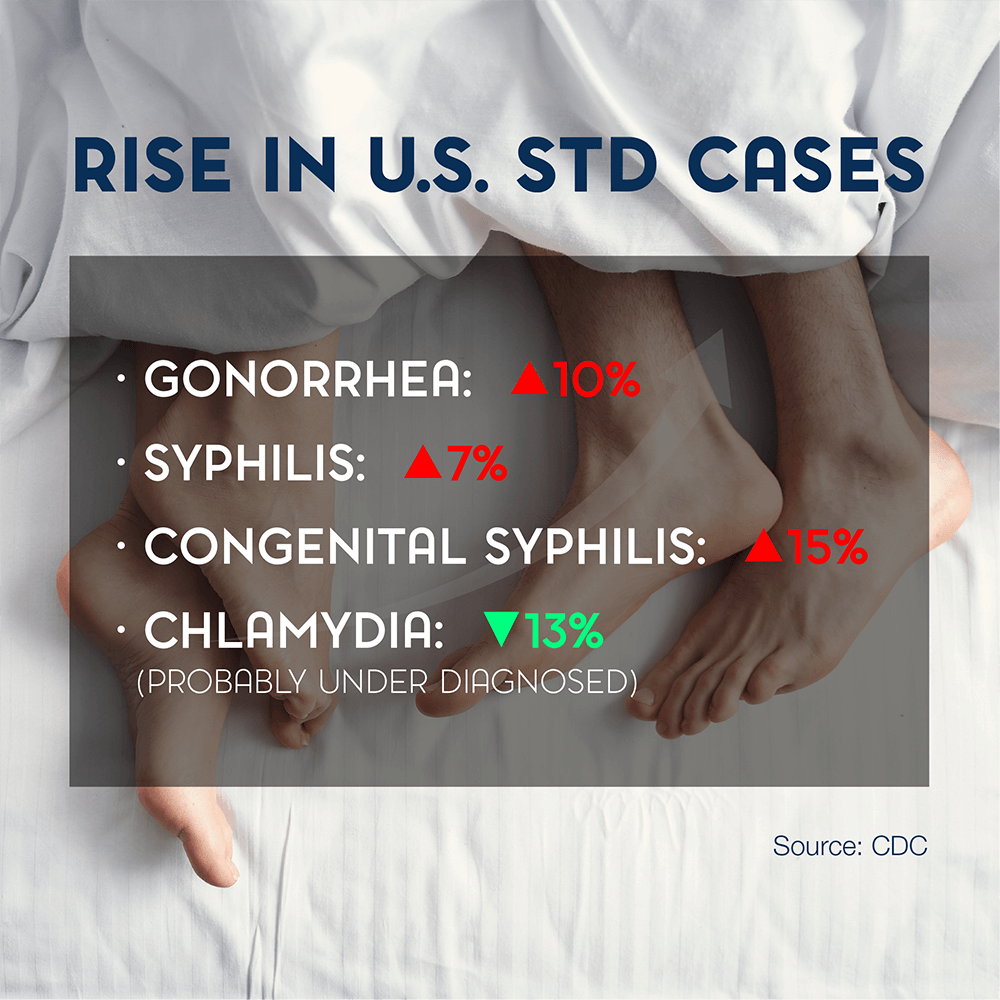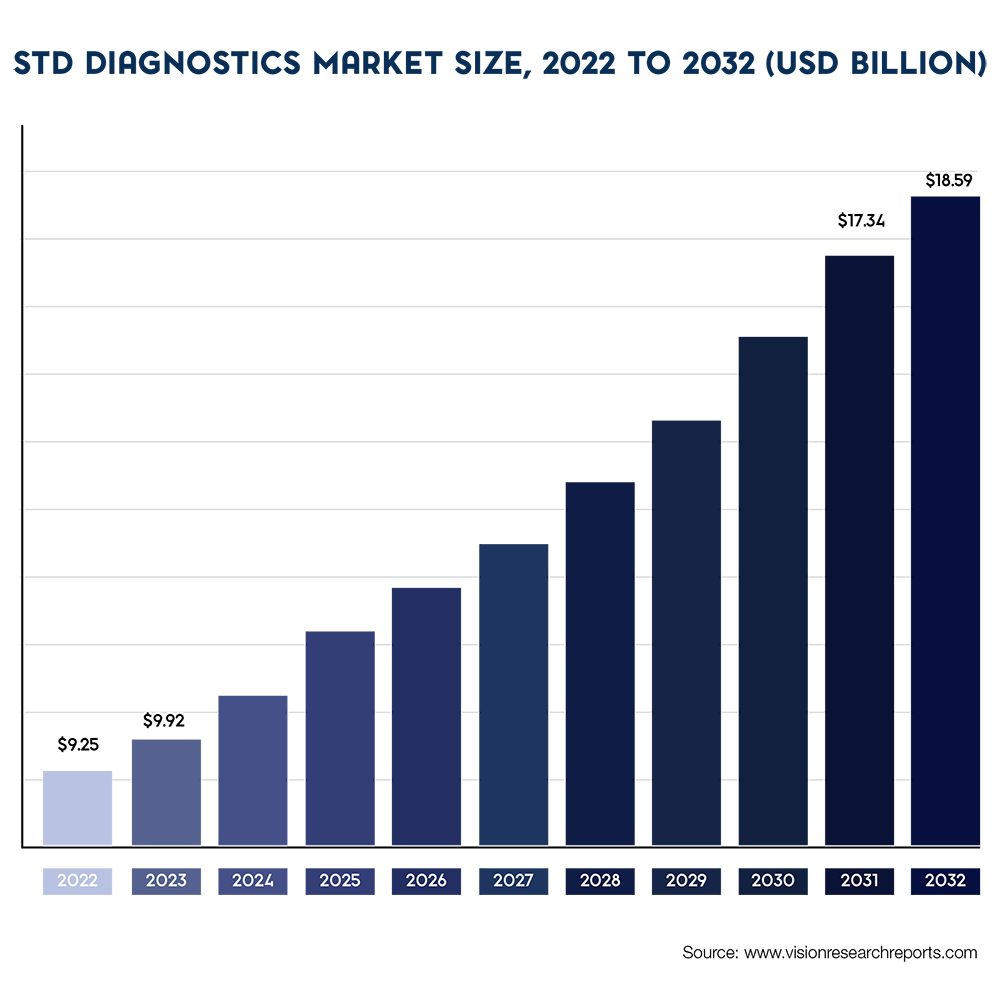More than one million sexually transmitted diseases and infections (STDs and STIs) are acquired every day worldwide and eight pathogens are responsible for the majority of them: human immunodeficiency virus (HIV), hepatitis B (HBV), herpes simplex virus (HSV), human papillomavirus (HPV), syphilis, gonorrhea, chlamydia and trichomoniasis.
The Silent Surge in STDs
Preventing the spread of sexually transmitted diseases has been the cornerstone of public health efforts for decades. Still, many factors, such as asymptomatic infections, lack of accessible healthcare services, and the stigma around discussing sexual health, continue to pose significant challenges in effectively controlling disease transmission. Worryingly, since the COVID-19 pandemic, there has been a notable increase in the reported cases of several STDs worldwide. According to the CDC, in the U.S. alone, reported cases of gonorrhea and primary and secondary syphilis were up 10% and 7% in 2020, respectively, compared with 2019; and congenital syphilis increased by almost 15%1.

STD Diagnostics Market Growth to 2032
In response to the rise of STDs, more products for STD testing, in particular HIV testing, are entering the market and new tools are being introduced that make testing easier and more accessible. Overall, the market is predicted to experience significant growth over the next decade, increasing at a GAGR of 7.23% from USD 9.25B (2022) to USD 18.29B (2032)2. While the laboratory testing segment currently dominates the market with a share of 79%, the future growth driver is expected to be point-of-care testing due to a growing demand for a more patient-centric testing model. In particular home testing and alternative sample types that allow for easy self-sampling (e.g. saliva and urine)3, are gaining traction in the market as individuals are increasingly open to the idea of self-testing post-COVID, creating new channels for STD health monitoring and STD diagnostics.

Another major shift is a move towards more molecular diagnostics for the diagnosis of STDs4. Immunoassay testing currently accounts for 45% of the STD market however, technological advancements focused on multiplex molecular analysis combined with an increasing need for automation to cope with the rising rates STDs, is driving more molecular-based testing on both point-of-care and high-throughput fully automated systems.
Overall, the STD diagnostics market will significantly evolve over the next decade in response to the complex challenges posed by the rising rates of sexually transmitted diseases. Advances in technology, coupled with increased awareness and innovative testing approaches, are pivotal in shaping a future where early detection and intervention can effectively mitigate the impact of STDs. Driven by targets set by the World Health Organization (WHO) to end the STD epidemic as a major public health concern5, more collaborative efforts will be needed between healthcare providers, policymakers, and the private sector in order to create a comprehensive and accessible sexual health ecosystem.
Meridian’s Molecular & Immunoassay STD Diagnostic Solutions
As a leader in infectious diseases, Meridian Bioscience has supported assay developers for over 45 years with innovative reagent solutions for STD diagnostic assays. With over 200 antigens and antibodies for STD immunoassay testing, and a large range of master mixes and enzymes for qPCR and isothermal amplification applications, Meridian is ready to provide solutions, big and small for the growth STD industry.
To learn more, visit Meridian’s complete STD solutions webpage: https://info.meridianbioscience.com/meridian-reagent-solutions-for-std-diagnostics.
References:
- Centers for Disease Control and Prevention. Impact of COVID-19 on STDs. https://www.cdc.gov/std/statistics/2021/impact.htm. Accessed Nov 15, 2023.
- Biospace. (2023, Aug 04) STD Diagnostics Market Size, Trends, Company Analysis and Forecast 2023-2032. https://www.biospace.com/article/std-diagnostics-market-size-trends-company-analysis-and-forecast-2023-2032/?keywords=COVID+19+vaccine
- Melendez, J.H., et al. (2021). Home-Based Testing for Sexually Transmitted Infections: Leveraging Online Resources During the COVID-19 Pandemic. Sex Transm Dis;48(1):e8-e10. doi:10.1097/OLQ.0000000000001309
- ReportLinker (2022, August 04). STD Diagnostics Market – Growth, Trends, COVID-19 Impact, and Forecasts (2022 – 2027) [Press Release].
- World Health Organization (2022, 2 September). New strategies to tackle and end STIs epidemics. https://www.who.int/news/item/02-09-2022-new-strategies-to-tackle-and-end-stis-epidemics